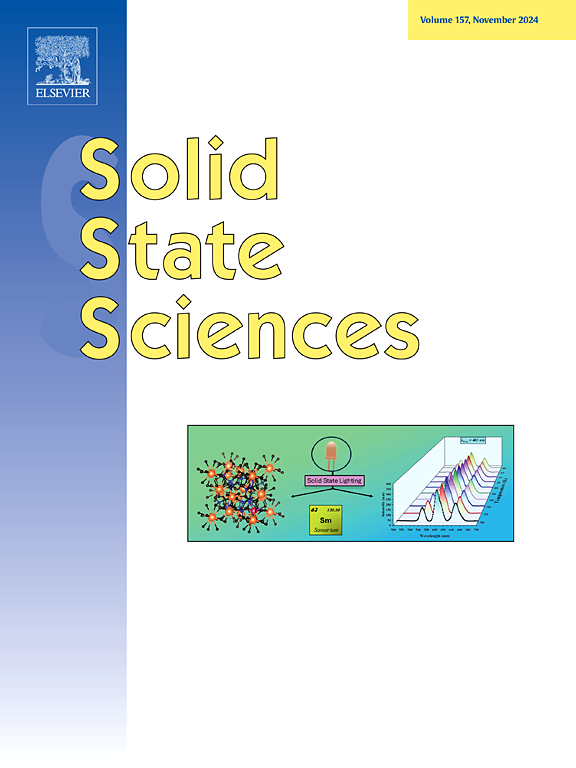层次化有机-无机聚苯胺/CuWO4纳米复合材料作为高性能、鲁棒的先进超级电容器电极
IF 3.3
3区 化学
Q2 CHEMISTRY, INORGANIC & NUCLEAR
引用次数: 0
摘要
开发具有高能量密度和强大循环稳定性的先进超级电容器电极材料仍然是下一代储能系统的关键挑战。结合导电聚合物和过渡金属氧化物的杂化纳米复合材料为克服这些限制提供了一条很有前途的途径。在本研究中,通过苯胺在CuWO4纳米粒子存在下的原位氧化聚合,合成了聚苯胺(PANI)/CuWO4纳米复合材料,并使用滴铸法将所得材料直接沉积在镍片(NS)衬底上,而不添加粘合剂。利用FESEM、TEM、XRD、XPS和EDS等分析手段对复合材料的结构和形态进行了表征,揭示了PANI/CuWO4纳米复合材料具有层次化的花状结构。通过循环伏安法和恒流充放电(GCD)测量,在6 M KOH电解质的双电极配置下评估了电化学性能。PANI/CuWO4/NS电极在0.5 A g−1时的比电容为323 F g−1,能量密度为16.16 Wh kg−1,经过大量循环后的电容保持率为90.75%。通过BET和TEM证实,分层多孔结构促进了离子/电子的快速传递,并在重复充放电循环中缓冲了机械应力。这些结果表明,聚苯胺/CuWO4/NS纳米复合材料是一种高效耐用的先进超级电容器电极材料。本文章由计算机程序翻译,如有差异,请以英文原文为准。

Hierarchical organic-inorganic PANI/CuWO4 nanocomposite as high-performance and robust electrode for advanced supercapacitors
The development of advanced supercapacitor electrode materials with high energy density and robust cycling stability remains a critical challenge for next-generation energy storage systems. Hybrid nanocomposites combining conductive polymers and transition metal oxides offer a promising route to overcome these limitations by integrating the merits of both components. In this study, a polyaniline (PANI)/CuWO4 nanocomposite was synthesized through in situ oxidative polymerization of aniline in the presence of CuWO4 nanoparticles, and the resulting material was directly deposited onto a nickel sheet (NS) substrate using a drop-casting method without the addition of binders. The structural and morphological properties of the composite were characterized using FESEM, TEM, XRD, XPS, and EDS analyses, which collectively revealed a hierarchical flower-like nanosheet architecture for the PANI/CuWO4 nanocomposite. Electrochemical performance was evaluated in a two-electrode configuration with 6 M KOH electrolyte via cyclic voltammetry and galvanostatic charge–discharge (GCD) measurements. The PANI/CuWO4/NS electrode exhibited an outstanding specific capacitance of 323 F g−1 at 0.5 A g−1, a high energy density of 16.16 Wh kg−1, and excellent capacitance retention of 90.75 % after extensive cycling. The hierarchical porous architecture, confirmed by BET and TEM, facilitated rapid ion/electron transport and buffered mechanical stress during repeated charge/discharge cycles. These results highlight the PANI/CuWO4/NS nanocomposite as a highly efficient and durable electrode material for advanced supercapacitor applications.
求助全文
通过发布文献求助,成功后即可免费获取论文全文。
去求助
来源期刊

Solid State Sciences
化学-无机化学与核化学
CiteScore
6.60
自引率
2.90%
发文量
214
审稿时长
27 days
期刊介绍:
Solid State Sciences is the journal for researchers from the broad solid state chemistry and physics community. It publishes key articles on all aspects of solid state synthesis, structure-property relationships, theory and functionalities, in relation with experiments.
Key topics for stand-alone papers and special issues:
-Novel ways of synthesis, inorganic functional materials, including porous and glassy materials, hybrid organic-inorganic compounds and nanomaterials
-Physical properties, emphasizing but not limited to the electrical, magnetical and optical features
-Materials related to information technology and energy and environmental sciences.
The journal publishes feature articles from experts in the field upon invitation.
Solid State Sciences - your gateway to energy-related materials.
 求助内容:
求助内容: 应助结果提醒方式:
应助结果提醒方式:


